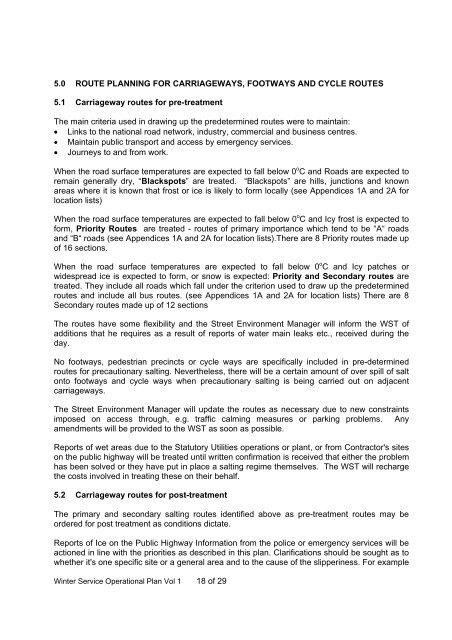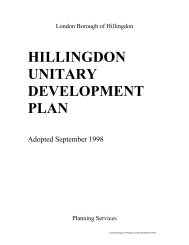Report - London Borough of Hillingdon
Report - London Borough of Hillingdon
Report - London Borough of Hillingdon
Create successful ePaper yourself
Turn your PDF publications into a flip-book with our unique Google optimized e-Paper software.
5.0 ROUTE PLANNING FOR CARRIAGEWAYS, FOOTWAYS AND CYCLE ROUTES<br />
5.1 Carriageway routes for pre-treatment<br />
The main criteria used in drawing up the predetermined routes were to maintain:<br />
• Links to the national road network, industry, commercial and business centres.<br />
• Maintain public transport and access by emergency services.<br />
• Journeys to and from work.<br />
When the road surface temperatures are expected to fall below 0 o C and Roads are expected to<br />
remain generally dry, “Blackspots” are treated. “Blackspots” are hills, junctions and known<br />
areas where it is known that frost or ice is likely to form locally (see Appendices 1A and 2A for<br />
location lists)<br />
When the road surface temperatures are expected to fall below 0 o C and Icy frost is expected to<br />
form, Priority Routes are treated - routes <strong>of</strong> primary importance which tend to be “A“ roads<br />
and “B“ roads (see Appendices 1A and 2A for location lists).There are 8 Priority routes made up<br />
<strong>of</strong> 16 sections.<br />
When the road surface temperatures are expected to fall below 0 o C and Icy patches or<br />
widespread ice is expected to form, or snow is expected: Priority and Secondary routes are<br />
treated. They include all roads which fall under the criterion used to draw up the predetermined<br />
routes and include all bus routes. (see Appendices 1A and 2A for location lists) There are 8<br />
Secondary routes made up <strong>of</strong> 12 sections<br />
The routes have some flexibility and the Street Environment Manager will inform the WST <strong>of</strong><br />
additions that he requires as a result <strong>of</strong> reports <strong>of</strong> water main leaks etc., received during the<br />
day.<br />
No footways, pedestrian precincts or cycle ways are specifically included in pre-determined<br />
routes for precautionary salting. Nevertheless, there will be a certain amount <strong>of</strong> over spill <strong>of</strong> salt<br />
onto footways and cycle ways when precautionary salting is being carried out on adjacent<br />
carriageways.<br />
The Street Environment Manager will update the routes as necessary due to new constraints<br />
imposed on access through, e.g. traffic calming measures or parking problems. Any<br />
amendments will be provided to the WST as soon as possible.<br />
<strong>Report</strong>s <strong>of</strong> wet areas due to the Statutory Utilities operations or plant, or from Contractor's sites<br />
on the public highway will be treated until written confirmation is received that either the problem<br />
has been solved or they have put in place a salting regime themselves. The WST will recharge<br />
the costs involved in treating these on their behalf.<br />
5.2 Carriageway routes for post-treatment<br />
The primary and secondary salting routes identified above as pre-treatment routes may be<br />
ordered for post treatment as conditions dictate.<br />
<strong>Report</strong>s <strong>of</strong> Ice on the Public Highway Information from the police or emergency services will be<br />
actioned in line with the priorities as described in this plan. Clarifications should be sought as to<br />
whether it's one specific site or a general area and to the cause <strong>of</strong> the slipperiness. For example<br />
Winter Service Operational Plan Vol 1 18 <strong>of</strong> 29
















